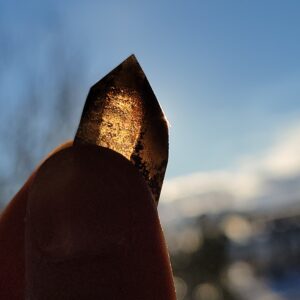Description
Goethite has a hardness of 5 – 5½ and a specific gravity of 4.27 – 4.29, while Quartz is the model mineral for a hardness of 7 and has a specific gravity of 2.65 – 2.66. Goethite is 63% Iron, 36% Oxygen, and 1% Hydrogen, while Quartz is around 47% Silicon and 53% Oxygen. This specimen would make for a decent Iron, Silicon, or Oxygen sample for element collectors, but as it’s a crystal and it’s more prized by mineral collectors and rock lovers than something else like the other Goethite waiting to come home with you – https://youtu.be/ulUlPnSo3Vk, it may not be the most economical sample, but it’d sure be your best looking!
According to Mindat, Goethite is “the most common simple iron oxide mineral. A weathering product of numerous iron-bearing minerals. Named in 1806 by Johann Georg Lenz in honor of the German poet, novelist, playwright, philosopher, politician, and geoscientist Johann Wolfgang von Goethe. Goethe was Chief Minister of State of Weimar.” According to Wikipedia, “it is found in soil and other low-temperature environments such as sediment. Goethite has been well known since ancient times for its use as a pigment (brown ochre). Evidence has been found of its use in paint pigment samples taken from the caves of Lascaux in France.” It’s pretty cool to think that for more than 17,000 years, this mineral has been utilized as a paint!
Also according to Mindat, “Quartz has been known and appreciated since pre-historic times. The most ancient name known is recorded by Theophrastus in about 300-325 BCE, κρύσταλλος or kristallos. The varietal names, rock crystal and bergcrystal, preserve the ancient usage. The root words κρύοσ signifying ice cold and στέλλειυ to contract (or solidify) suggest the ancient belief that kristallos was permanently solidified ice. The earliest printed use of “querz” was anonymously published in 1505, but attributed to a physician in Freiberg, Germany, Ulrich Rülein von Kalbe (a.k.a. Rülein von Calw, 1527). Agricola used the spelling “quarzum” (Agricola 1530) as well as “querze”, but Agricola also referred to “crystallum”, “silicum”, “silex”, and silice”. Tomkeieff (1941) suggested an etymology for quartz: “The Saxon miners called large veins – Gänge, and the small cross veins or stringers – Querklüfte. The name ore (Erz, Ertz) was applied to the metallic minerals, the gangue or to the vein material as a whole. In the Erzgebirge, silver ore is frequently found in small cross veins composed of silica. It may be that this ore was called by the Saxon miners ‘Querkluftertz’ or the cross-vein-ore. Such a clumsy word as ‘Querkluftertz’ could easily be condensed to ‘Querertz’ and then to ‘Quertz’, and eventually become ‘Quarz’ in German, ‘quarzum’ in Latin and ‘quartz’ in English.” Tomkeieff (1941, q.v.) noted that “quarz”, in its various spellings, was not used by other noted contemporary authors. “Quarz” was used in later literature referring to the Saxony mining district, but seldom elsewhere.”
There are thousands of recorded localities all over the world for both Goethite and Quartz, and while Smoky Quartz may be a little more rare, as it’s caused by gamma irradiation and the presence of traces of aluminum built into its crystal lattice, it’s still found in more than a thousand locations worldwide. However, due to its crystalline beauty, and especially this specimen, with a stunning bit of Goethite attached, Smoky Quartz can be quite valued, so be sure to keep your eye out for a cool crystal like this on your next hike!
t’s being shown to you with an awesome song, “Fool in Love” by @ZolophtMusic , which is pretty fitting, as this crystal will have you feeling like a fool in love! – Go subscribe to them and listen to their other awesome songs! The original song can be found here – https://youtu.be/bprRLpzJZ20




























Reviews
There are no reviews yet.